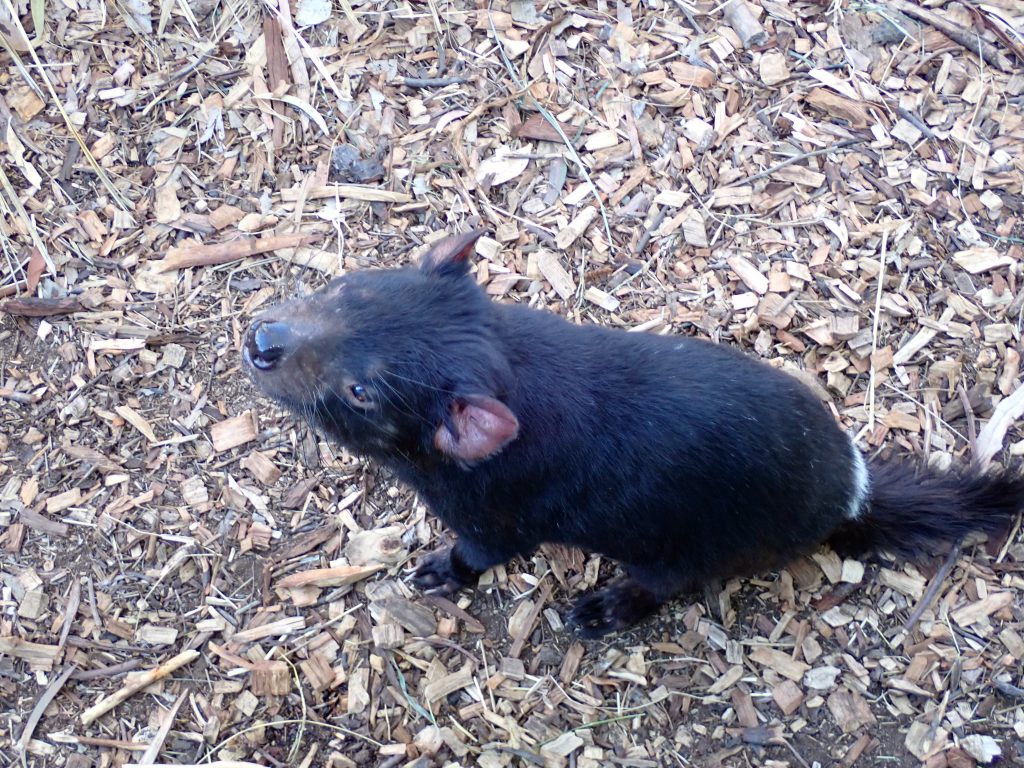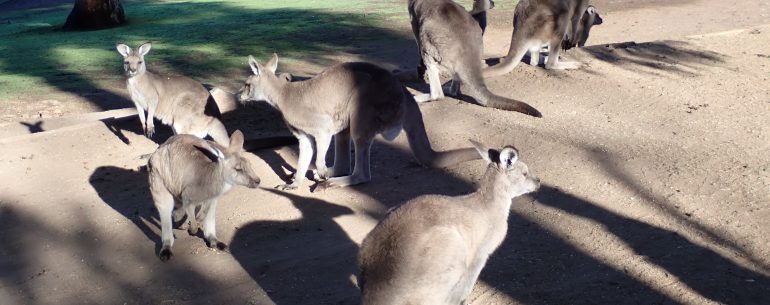A day of travel today …. However, our flight from Hobart was not until about 2pm, so for the morning we decided to head a little north of Hobart to Bonorong Wildlife Park. We got there a little time before the tour, so wandered around for a bit spending ages in front of cages looking for animals that were asleep, given that they were nocturnal! We did manage to see the spotted quolls curled up in their tree trunk nests, but apart from that, much time was spent staring at what appeared to be, but weren’t, empty pens.
At 10am the tour started and was fascinating. The volunteer doing it was very knowledgeable, but clearly also passionate about the animals they look after. As he said from the outset, they are not a zoo – in fact they would prefer to have absolutely no animals at all to show us – but a rescue centre. Animals who are injured or perhaps too ‘humanised’ to be returned to the wild make up the core of their visitors, but they also take in joeys or other children who have perhaps lost their mother as a result of a predator and raise them with the aim always be to return them to the wild if at all possible.
He showed us all the birds they had – green rosellas, red-tailed black cockatoos, sulphur-crested cockatoos (one of which was over 100 years old and an ex-pet!),yellow-tailed black cockatoos and galahs. He then moved on to the Tassie Devils (Sarcophilus harisii). What devils lack in size (and they are only the size of small dogs) they make up for in noise and ferocity -hence the early European settlers calling them ‘devils’. They now only occur in Tasmania and vanished from the Australian mainland long before European settlement, probably due to the spread of dingoes. The settlers on Van Diemens Land generally regarded them as a nuisance and in many cases a bounty was put on their head – in 1830 a male was worth 2/6, while a female would get you 3/6. Interesting how values have changed …. These bounties led to them being trapped and poisoned for over a century and they were almost wiped out, but finally they were protected by law in 1941.

They are sometimes described as hunters and, if necessary, they will hunt, but they are not great at it. Chickens can apparently run at 15 km/h whereas devils can only manage 14 km/h, so as long as the chicken has a head start …..! However, they can keep going and if necessary will cover long distances for any prey. Rather than hunters they are probably better described as scavengers and they will clean up anything and everything. Their sharp teeth mean that they can eat an entire carcass – bones and everything. This does mean that they have a fondness for roadkill, but unfortunately their road safety awareness is not as good as their sense of small and they will often become victims as well of cars driving too fast at night.
The devils are the largest of the carnivorous marsupials – the others are the quolls and antechinus (marsupial mice). The female gives birth to far more young than she can feed, so as soon as they are born they compete to find one of her four teats. Once there (in the rear-facing pouch) they stay firmly attached to the teat for four months and it is only after that time that they start venturing out. They stay with their mothers until around 9 months of age and then they are on their own with an expected lifespan of somewhere around 6 years.
The final animal we were shown was the echidna. The echidna they were looking after had been in an accident, but while with them, they realised that she was blind, so she will live out her time at the sanctuary. The echidnas and the platypus are the only living mammals who lay eggs and are known as monotremes. One possible derivation of their name is that they were named after Echidna, a creature from Greek mythology who was half-woman, half-snake. A more pragmatic suggestion is that it is confusion with an Ancient Greek word (ekhinos) which means literally a hedgehog or sea urchin and the similarities are ovbvious! They are essentially ant-eaters and are sometimes even called spiny ant-eaters and this means that they are very powerful diggers and their predator response is to wedge themselves in the ground with their claws and stick their spines up.

A useless fact about echidnas is that the first European drawing of one was made in Adventure Bay in Tasmania by third lieutenant George Tobin during William Bligh’s second breadfruit voyage.
After a very interesting time at Bonorong, we headed back to the airport to go through the usual cycle of hang around, walk somewhere else, hang around, board, hang around (literally!), walk somewhere else, hang around …. until eventually we picked up our hire car and headed to our accommodation on Kangaroo Point.
